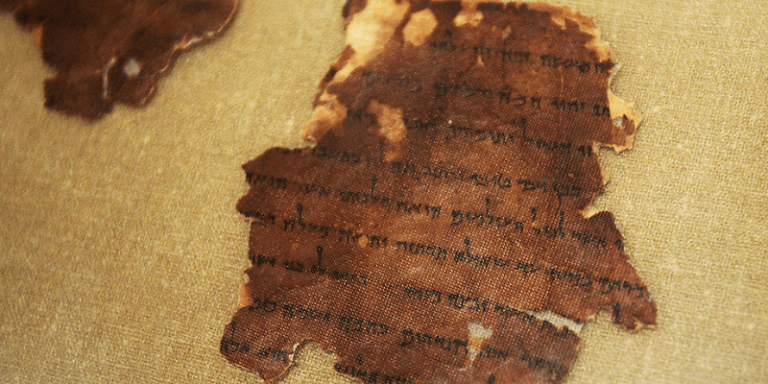The Spill: Ancient Words Find a New Light
Weekly news you can use.
By: GenZ Staff | March 22, 2021 | 799 Words

(Photo by Chris Hondros/Getty Images)
Additional Dead Sea Scrolls Discovered
For the first time in 60 years, ancient Bible texts have been discovered in an Israeli desert. The latest fragments, which are believed to be over 2,000 years old, are thought to have been hidden during a Jewish revolution against Rome. They’re portions of the Book of the Twelve Minor Prophets and the books of Nahum and Zechariah.
The texts are in Greek, and the passage discovered, Nahum 1:5–6, speaks volumes: “The mountains quake because of Him, And the hills melt. The earth heaves before Him, The world and all that dwell therein. Who can stand before His wrath? Who can resist His fury? His anger pours out like fire, and rocks are shattered because of Him.”
 An expert with the Israel Antiquities Authority points out that these words are different from other versions of the Bible and demonstrate how biblical text has changed over time. The first batch of Dead Sea Scrolls was found by a Bedouin shepherd in 1947. For years, scholars have argued over who they think wrote them. There are about 900 texts all together that date back to as early as the third century B.C. and contain hymns, psalms, calendars, and early copies of the Hebrew Bible.
An expert with the Israel Antiquities Authority points out that these words are different from other versions of the Bible and demonstrate how biblical text has changed over time. The first batch of Dead Sea Scrolls was found by a Bedouin shepherd in 1947. For years, scholars have argued over who they think wrote them. There are about 900 texts all together that date back to as early as the third century B.C. and contain hymns, psalms, calendars, and early copies of the Hebrew Bible.
Avi Cohen, CEO of the Ministry of Jerusalem and Heritage, is excited to share the findings: “These finds are not just important to our own cultural heritage but to that of the entire world.” Other items discovered include a collection of coins bearing Jewish symbols, arrowheads and spearheads, woven fabric, sandals, and lice combs. Experts believe these items are from the end of the Bar Kokhba Revolt (132-136 A.D.) when Jews fought against Roman rule.
It’s All for the Birds
It’s lights out for one east coast city as the safety of migrating birds in flight is finally being addressed. It seems that skyscraper illumination is certain death for some birds making the trek from cooler to warmer climes and back again, and Philadelphia is going to change the game for our feathered friends. Beginning April 1, the downtown businesses and residences in high-rise buildings will turn off their lights to help the birds navigate through the city.
Birds use the stars and moon to guide them at night, and the artificial lights cause disorientation during flight. On cloudy nights, the birds cannot see the sky, making matters even worse. Last October, an estimated 1,000 to 1,500 birds died in a single night in just a three-block radius.
But the deaths of migratory birds began long ago. Jason Weckstein, the associate curator of ornithology at Drexel University’s Academy of Natural Sciences, shared this with the Associated Press: “We have specimens in the academy’s ornithology collection from a kill that happened when lights were first installed on Philadelphia’s City Hall tower in 1896.”
The program is called Lights Out Philly, and it will run April 1 through May 31. The fall season will begin August 15 and continue through November 15. Program participants will shut off their lights between midnight and 6 a.m.
According to the National Audubon Society, other major metropolitan cities – New York, Boston, Atlanta, and Washington D.C. – already participate in the program. It began in 1999 in Chicago.
Not only will countless birds be saved, but carbon emissions and energy costs should drop as well. Doing the right thing reaps a myriad of rewards.
A School Made By a 3-D Printer? It’s a Game Changer
As a young girl, Maggie Grout was bothered that nearly 250 million children worldwide were not educated because they had no schools to attend. When she was fifteen years old, she started her own 501(c)3 non-profit company called Thinking Huts. Using her skills and humanitarian passions, she hoped to solve the problem by building schools around the world.
Now a senior at the University of Colorado studying business management and entrepreneurship, Grout is about to see her dream finally become a reality. The first school to roll off a 3-D printer is set for construction in Madagascar’s African island nation. For Grout, it was all about solving financing and reworking the traditional builds of classrooms into something much more affordable. Miss Grout explains:
“Compared to traditional construction, 3-D printed schools can be built in a fraction of the time while also reducing waste, since the walls are honeycombed and hollow. Another benefit is that 3-D printing significantly decreases costs with economies of scale.”
Miss Grout’s 3-D schools cost less than half as much as traditional building methods, and the Madagascar build will take approximately $20,000 to complete. Miss Grout’s new schools are set to improve the educational opportunities of millions – Madagascar is just the beginning. And she is optimistic: “If all goes to plan we will be open by the start of the new year with classes in session.”

















